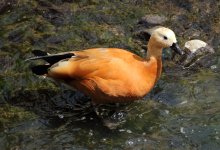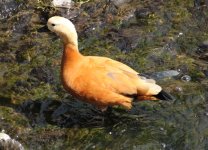michalb
Well-known member

Hello all,
my question is not exactly the one on identification, but rather on the status of several birds - if this subforum is unsuitable for this kind of discussion, I apologize and would kindly ask the administrators/moderators to move it.
All those birds were seen in the island of Madeira in October this year.
First, the Ruddy Shelduck I met every day on the banks of a small river - is it possible it was a natural vagrant? In the same place there were also a few Muscovy Ducks, but I assume those are domesticated turned feral (although Avibase's checklist does not mark this species as introduced?)
Another one is the Glossy Ibis, which foraged for a few days near the estuary of the same river. This one couldn't be feral I think, but as I remember from looking through the "Birds of the Atlantic Islands" field guide (I don't own the book), it has been noted only once or twice in Madeira, so am I really lucky and should report the sighting to some authorities?
Rock Pigeon - is the population on Madeira wild or rather introduced/feral? I think most of birds in more remote location had "wild type" plumage.
Fourth question - what swifts stay in Madeira until mid-October? I couldn't find information on that other than that Plain Swift is May-August visitor, but can overwinter (Mullarney&Svensson field guide). What about Pallid Swift? I assume the Common Swifts should be already gone or shouldn't they?
Finally, I'm just looking for confirmation that the Common Waxbills have been introduced to the island, like to many other places.
If anyone can bother to answer any of my questions and doubts, I'll be very grateful. I probably wouldn't ask at least some of them if I had "Birds of the Atlantic Islands" copy on hand. I hope this Glossy Ibis was really a rare sighting which will go as the bird highlight of my vacation
Regards,
Michal
my question is not exactly the one on identification, but rather on the status of several birds - if this subforum is unsuitable for this kind of discussion, I apologize and would kindly ask the administrators/moderators to move it.
All those birds were seen in the island of Madeira in October this year.
First, the Ruddy Shelduck I met every day on the banks of a small river - is it possible it was a natural vagrant? In the same place there were also a few Muscovy Ducks, but I assume those are domesticated turned feral (although Avibase's checklist does not mark this species as introduced?)
Another one is the Glossy Ibis, which foraged for a few days near the estuary of the same river. This one couldn't be feral I think, but as I remember from looking through the "Birds of the Atlantic Islands" field guide (I don't own the book), it has been noted only once or twice in Madeira, so am I really lucky and should report the sighting to some authorities?
Rock Pigeon - is the population on Madeira wild or rather introduced/feral? I think most of birds in more remote location had "wild type" plumage.
Fourth question - what swifts stay in Madeira until mid-October? I couldn't find information on that other than that Plain Swift is May-August visitor, but can overwinter (Mullarney&Svensson field guide). What about Pallid Swift? I assume the Common Swifts should be already gone or shouldn't they?
Finally, I'm just looking for confirmation that the Common Waxbills have been introduced to the island, like to many other places.
If anyone can bother to answer any of my questions and doubts, I'll be very grateful. I probably wouldn't ask at least some of them if I had "Birds of the Atlantic Islands" copy on hand. I hope this Glossy Ibis was really a rare sighting which will go as the bird highlight of my vacation
Regards,
Michal







